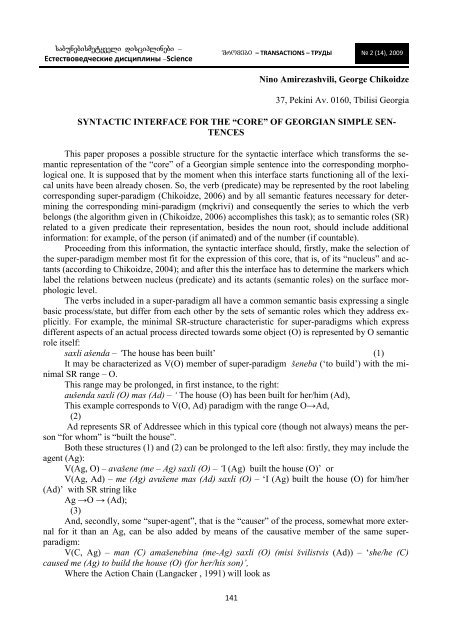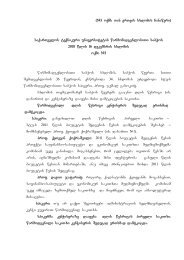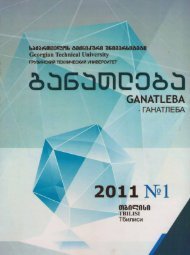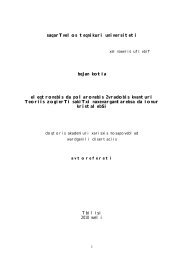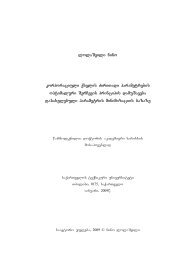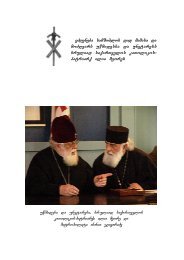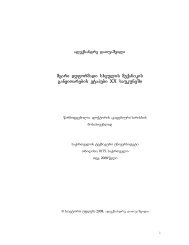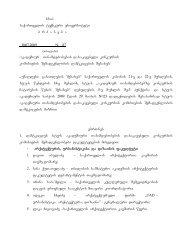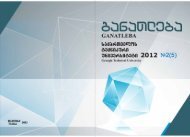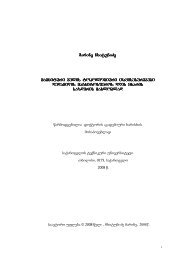Sromebi 2 (14) Works 2 (14) ТÑÑÐ´Ñ 2 (14) - Newsletters
Sromebi 2 (14) Works 2 (14) ТÑÑÐ´Ñ 2 (14) - Newsletters
Sromebi 2 (14) Works 2 (14) ТÑÑÐ´Ñ 2 (14) - Newsletters
You also want an ePaper? Increase the reach of your titles
YUMPU automatically turns print PDFs into web optimized ePapers that Google loves.
sabunebismetyveli disciplinebi –Естествоведческие дисциплины –Science<strong>Sromebi</strong> – TRANSACTIONS – ТРУДЫ № 2 (<strong>14</strong>), 2009Nino Amirezashvili, George Chikoidze37, Pekini Av. 0160, Tbilisi GeorgiaSYNTACTIC INTERFACE FOR THE “CORE” OF GEORGIAN SIMPLE SEN-TENCESThis paper proposes a possible structure for the syntactic interface which transforms the semanticrepresentation of the “core” of a Georgian simple sentence into the corresponding morphologicalone. It is supposed that by the moment when this interface starts functioning all of the lexicalunits have been already chosen. So, the verb (predicate) may be represented by the root labelingcorresponding super-paradigm (Chikoidze, 2006) and by all semantic features necessary for determiningthe corresponding mini-paradigm (mçkrivi) and consequently the series to which the verbbelongs (the algorithm given in (Chikoidze, 2006) accomplishes this task); as to semantic roles (SR)related to a given predicate their representation, besides the noun root, should include additionalinformation: for example, of the person (if animated) and of the number (if countable).Proceeding from this information, the syntactic interface should, firstly, make the selection ofthe super-paradigm member most fit for the expression of this core, that is, of its “nucleus” and actants(according to Chikoidze, 2004); and after this the interface has to determine the markers whichlabel the relations between nucleus (predicate) and its actants (semantic roles) on the surface morphologiclevel.The verbs included in a super-paradigm all have a common semantic basis expressing a singlebasic process/state, but differ from each other by the sets of semantic roles which they address explicitly.For example, the minimal SR-structure characteristic for super-paradigms which expressdifferent aspects of an actual process directed towards some object (O) is represented by O semanticrole itself:saxli ašenda – ‘The house has been built’ (1)It may be characterized as V(O) member of super-paradigm šeneba (‘to build’) with the minimalSR range – O.This range may be prolonged, in first instance, to the right:aušenda saxli (O) mas (Ad) – ‘ The house (O) has been built for her/him (Ad),This example corresponds to V(O, Ad) paradigm with the range O→Ad,(2)Ad represents SR of Addressee which in this typical core (though not always) means the person“for whom” is “built the house”.Both these structures (1) and (2) can be prolonged to the left also: firstly, they may include theagent (Ag):V(Ag, O) – avašene (me – Ag) saxli (O) – ‘I (Ag) built the house (O)’ orV(Ag, Ad) – me (Ag) avušene mas (Ad) saxli (O) – ‘I (Ag) built the house (O) for him/her(Ad)’ with SR string likeAg →O → (Ad);(3)And, secondly, some “super-agent”, that is the “causer” of the process, somewhat more externalfor it than an Ag, can be also added by means of the causative member of the same superparadigm:V(C, Ag) – man (C) amašenebina (me-Ag) saxli (O) (misi švilistvis (Ad)) – ‘she/he (C)caused me (Ag) to build the house (O) (for her/his son)’,Where the Action Chain (Langacker , 1991) will look as<strong>14</strong>1


